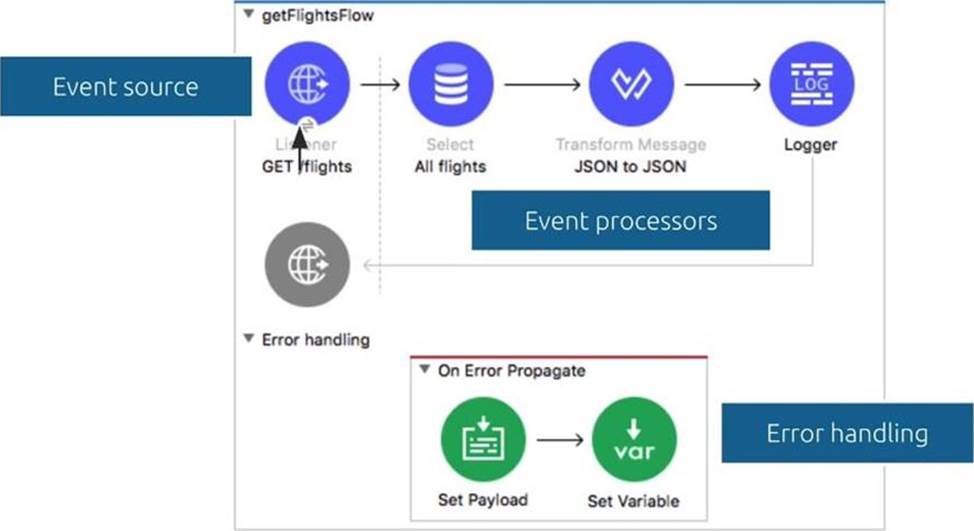Mulesoft MuleSoft Certified Developer-Level 1 MuleSoft Certified Developer-Level 1 (Mule 4) Online Training
Mulesoft MuleSoft Certified Developer-Level 1 Online Training
The questions for MuleSoft Certified Developer-Level 1 were last updated at Jan 28,2025.
- Exam Code: MuleSoft Certified Developer-Level 1
- Exam Name: MuleSoft Certified Developer-Level 1 (Mule 4)
- Certification Provider: Mulesoft
- Latest update: Jan 28,2025
What is minimal requirement in a flow for a Mule application to compile?
- A . Event Source
- B . Event Processors
- C . Error handlers
- D . Source and processors both
B
Explanation:
Process section is must to get compiles. Process section must have one or more processors

Diagram
Description automatically generated
What is minimal requirement in a flow for a Mule application to compile?
- A . Event Source
- B . Event Processors
- C . Error handlers
- D . Source and processors both
B
Explanation:
Process section is must to get compiles. Process section must have one or more processors

Diagram
Description automatically generated
What is minimal requirement in a flow for a Mule application to compile?
- A . Event Source
- B . Event Processors
- C . Error handlers
- D . Source and processors both
B
Explanation:
Process section is must to get compiles. Process section must have one or more processors

Diagram
Description automatically generated
What is minimal requirement in a flow for a Mule application to compile?
- A . Event Source
- B . Event Processors
- C . Error handlers
- D . Source and processors both
B
Explanation:
Process section is must to get compiles. Process section must have one or more processors

Diagram
Description automatically generated
What is minimal requirement in a flow for a Mule application to compile?
- A . Event Source
- B . Event Processors
- C . Error handlers
- D . Source and processors both
B
Explanation:
Process section is must to get compiles. Process section must have one or more processors

Diagram
Description automatically generated
What is minimal requirement in a flow for a Mule application to compile?
- A . Event Source
- B . Event Processors
- C . Error handlers
- D . Source and processors both
B
Explanation:
Process section is must to get compiles. Process section must have one or more processors

Diagram
Description automatically generated
What is minimal requirement in a flow for a Mule application to compile?
- A . Event Source
- B . Event Processors
- C . Error handlers
- D . Source and processors both
B
Explanation:
Process section is must to get compiles. Process section must have one or more processors

Diagram
Description automatically generated
What is minimal requirement in a flow for a Mule application to compile?
- A . Event Source
- B . Event Processors
- C . Error handlers
- D . Source and processors both
B
Explanation:
Process section is must to get compiles. Process section must have one or more processors

Diagram
Description automatically generated
get:
- A . 1
- B . 2
- C . 3
- D . 5
A
Explanation:
Correct answer is 5 as APIkit for REST generates a backend flow for each resource-action pairing in a RAML file.
MuleSOft Doc
Ref: https://docs.mulesoft.com/mule-runtime/4.2/build-application-from-api
Mule application contains ActiveMQ JMS dependency. Mule application was compiled and run successfully in Anypoint Studio. The mule application must now be exported from Anypoint Studio and shared with other developer.
What export options should be selected to create the smallest JAR file that can be imported into other developer’s Anypoint Studio and run successfully?
- A . Select only Attach Project Sources only
- B . Select both Attach Project Sources and Include project modules and dependencies option
- C . Select the Include project modules and dependencies option only
- D . De-select both Attach Project Sources and Include project modules and dependencies option
A
Explanation:
Correct answer is Select only Attach Project Sources only
You must keep the Attach Project Sources option selected to be able to import the packaged JAR file back into a Studio workspace.
Deselect the Include project modules and dependencies option.
This option skips bundling the actual modules and external dependencies required to run the Mule application in a Mule runtime engine, creating a lightweight JAR file package that does not include any dependencies specified in the Mule application’s pom.xml file.
The generated JAR file is not a functional deployable archive and cannot be deployed to a Mule runtime engine, but instead offers a way to archive only the source files that make up the Mule application. This is the same as using the -lightWeightPackage flag when
packaging using the Mule Maven Plugin and is useful if you want to distribute your project to other Studio installations because it only keeps a reference to all its dependencies. When you import a lightweight package into Studio, all your dependencies are automatically downloaded MuleSoft Doc
Ref: https://docs.mulesoft.com/studio/7.8/import-export-packages
Latest MuleSoft Certified Developer-Level 1 Dumps Valid Version with 99 Q&As
Latest And Valid Q&A | Instant Download | Once Fail, Full Refund

